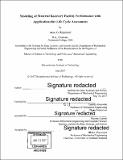| dc.contributor.advisor | Timothy Gutowski. | en_US |
| dc.contributor.author | Raymond, Anne G. (Anne Glidden) | en_US |
| dc.contributor.other | Technology and Policy Program. | en_US |
| dc.date.accessioned | 2017-09-15T15:27:55Z | |
| dc.date.available | 2017-09-15T15:27:55Z | |
| dc.date.copyright | 2017 | en_US |
| dc.date.issued | 2017 | en_US |
| dc.identifier.uri | http://hdl.handle.net/1721.1/111296 | |
| dc.description | Thesis: S.M. in Technology and Policy, Massachusetts Institute of Technology, School of Engineering, Institute for Data, Systems, and Society, Technology and Policy Program, 2017. | en_US |
| dc.description | Cataloged from PDF version of thesis. | en_US |
| dc.description | Includes bibliographical references (pages 115-118). | en_US |
| dc.description.abstract | Single stream recycling programs improve participation rates and divert more end-of-life products from landfill to recycling. The resulting mixture of waste must be sorted, however, before individual materials can be reprocessed for recycling. Material recovery facilities (MRFs) use a series of mechanical and manual sorting steps to separate the mixed stream of materials. The ability of MRFs to correctly sort materials is therefore a critical component of recycling systems. In this thesis, we apply a network flow model to evaluate the performance of sorting facility scenarios. We use experimental sorting efficiencies obtained through waste sampling at a functioning MRF, and explore how those efficiencies change under different operating conditions. We further apply the model to find the best configuration of a series of sorting units, optimizing for both profit and overall sorting efficiency. Recycling is promoted by the EPA and other organizations as a means of reducing the impact of material use. The benefits of recycling relative to landfill and incineration are determined using life cycle analysis (LCA), which takes into account material recovery rates. We apply modeled recovery rates for selected materials to a recycling LCA, and show that they directly impact the magnitude of estimated benefits. | en_US |
| dc.description.statementofresponsibility | by Anne G. Raymond | en_US |
| dc.format.extent | 118 pages | en_US |
| dc.language.iso | eng | en_US |
| dc.publisher | Massachusetts Institute of Technology | en_US |
| dc.rights | MIT theses are protected by copyright. They may be viewed, downloaded, or printed from this source but further reproduction or distribution in any format is prohibited without written permission. | en_US |
| dc.rights.uri | http://dspace.mit.edu/handle/1721.1/7582 | en_US |
| dc.subject | Institute for Data, Systems, and Society. | en_US |
| dc.subject | Engineering Systems Division. | en_US |
| dc.subject | Technology and Policy Program. | en_US |
| dc.title | Modeling of material recovery facility performance with applications for life cycle assessment | en_US |
| dc.title.alternative | Modeling of MRF performance with applications for life cycle assessment | en_US |
| dc.type | Thesis | en_US |
| dc.description.degree | S.M. in Technology and Policy | en_US |
| dc.contributor.department | Massachusetts Institute of Technology. Engineering Systems Division | |
| dc.contributor.department | Massachusetts Institute of Technology. Institute for Data, Systems, and Society | |
| dc.contributor.department | Technology and Policy Program | |
| dc.identifier.oclc | 1003284237 | en_US |
